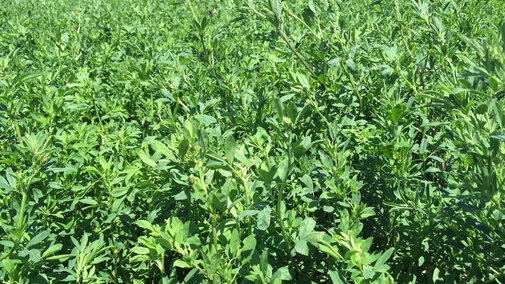The use of trade names or products does not indicate the promotion of products, these are strictly used for educational purposes. Information has been adapted from the 2020 Guide for Weed, Disease, and Insect Management in Nebraska.
Winter Annuals in Alfalfa
Plants like henbit, pennycress, shepherd’s purse, mustard, annual bluegrass, and cheatgrass are often a problem that seem to magically appear in alfalfa stands every spring. These winter annuals germinate in the fall and then go dormant over the winter. This gives them a head start in the spring, when they begin growing quickly as temperatures warm. This fast growth allows them to use nutrients and moisture before other plants have started to grow, and quickly mature and set seed. Scouting in early spring is the best way to categorize current weed problems and those that may become issues later in the season and into the following year.
In established stands, we first must decide if weed pressure is worth the cost of an herbicide treatment. For the first cutting, winter annuals can lower quality and palatability. If dairy quality hay is the goal, then cost of the treatment will likely be worth the expense. If hay will be fed to dry cows in the winter, the treatment costs may not be worth the benefit.
Roundup Ready® Alfalfa
Roundup Ready® Alfalfa varieties have made herbicide treatment of challenging weeds much easier, especially in fields with actively growing alfalfa. However, as with any herbicide application, target plant size is important. Label guidelines recommend treatment of weeds before they exceed 4” in height. Additionally, it is important to make applications before the alfalfa canopy begins interfering with spray pattern and distribution of product. Also note that not all glyphosate products may be labeled for use in alfalfa.
Post Control Options for Conventional Alfalfa
For newly seeded alfalfa stands mowing can be good a control option for broadleaf weeds. Increasing the height when mowing can be a good strategy as well. This can slow the growth of broadleaf weeds, while allowing the alfalfa seedlings to re-grow with reduced weed competition. Chemical control is also an option for broadleaf and grassy weeds in both newly seeded and established stands.
Pursuit® and Raptor® are two good post-emergent options that tend to cause less alfalfa injury and may be a better options for fields with growing alfalfa plants. Pursuit® and Raptor® are both Group 2 herbicides that can be used on established or seedling alfalfa. Pursuit® should be applied for seedling alfalfa at the 2nd trifoliate stage and when there is less than 3” of growth in established alfalfa. Raptor® should be applied when the weeds are less than 2” tall, seedling alfalfa is at the 2nd trifoliate stage and established alfalfa has less than 3” of growth. There is a 30-day feed, grazing, and harvest restriction following the application of Pursuit®. Pursuit® in particular can provide residual control for several weeks post application. These are more expensive options, but can provide control of particularly challenging weed problems.
Prowl H2O® is another product that can be used on seedling and established alfalfa as a post-emergent application. Applications can be made up to the 2nd trifoliate stage for seedling alfalfa whereas established alfalfa application can take place before the alfalfa is 6” tall. This product has a 28-day harvest restriction for applications under 4 pints of product and a 50-day restriction for anything over 4 pints of product. This product is listed as a post-emergence product, but best control is seen when applied before emergence of troublesome weeds.
In established alfalfa stands AIM® and Chateau® Herbicide SW are other options that could be used for post-emergent control only in established stands. AIM® can be used in-between cuttings up to 3” of growth, with a pre-harvest interval of 21 days. Chateau® Herbicide SW application can take place before the alfalfa is 6” tall, application after this timing could lead to damage on trifoliate. This product is not intended for alfalfa grass mixtures and do not apply this product within 25 days of planting or grazing.
For the control of downy bromegrass and annual bluegrass, Arrow® or Select Max® can be used as a post-emergent application in seedling and established alfalfa. Both products can be applied to control grassy weeds between 2 to 6” with a 15-day restriction on feeding, grazing, or harvest following application of either Arrow® or Select Max®. Always read and follow label instructions, specifically for feeding/grazing/harvest restrictions.

